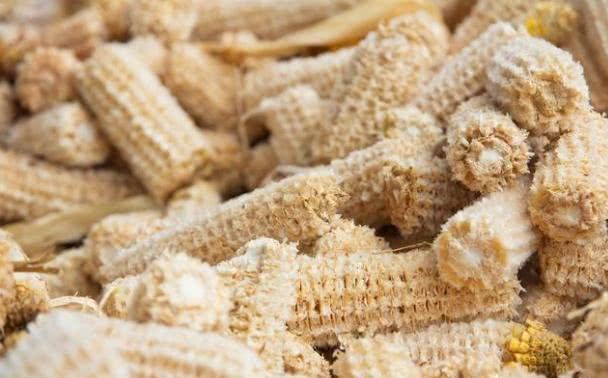How to grow Pleurotus ostreatus with a lot of corncob harvested in autumn?

Abstract: a lot of corncobs are harvested in autumn. How to plant Pleurotus ostreatus with corncobs?
Pleurotus ostreatus is a popular edible fungus in the market because of its high protein content, rich minerals and a wide range of amino acids. There are many kinds of ingredients for Pleurotus ostreatus cultivation, such as cottonseed hull, sawdust, wheat straw, rice straw, corncob and so on. After a period of time, there will be a large number of corncob supply at the end of autumn harvest. So how to grow Pleurotus ostreatus with corncob?
How to make corncob into Pleurotus ostreatus cultivation material?
There are generally three kinds of edible mushroom cultivation materials: clinker, raw material and fermentation material, and fermentation material is more commonly used. Fermentation materials are generally fermented by stacking, and the main steps include:
Prepare the ingredients. Select fresh, mildew-free corncob, sun-dried and crushed into corn kernels, and mix corncob, quicklime, wheat bran, nitrogen, phosphorus and potassium compound fertilizer according to the proportion of 80,4,15,1%. After mixing the raw materials evenly, according to the ratio of water to material at 2:1, the raw materials are fully wetted. In order to prevent the growth of other miscellaneous bacteria in the fermentation process, appropriate amount of carbendazim can be mixed and added in the raw materials.
The cultivation materials are stacked and fermented. The mixed cultivation materials were stacked and fermented for 12 hours to 1 day, during which when the fermentation reached more than 60 ℃, the pile was turned from top to bottom, from inside to outside, and committed for 2 or 3 times to ensure that the raw materials were fermented evenly. When the white hyphae appeared on the surface of the cultivated material, the fermentation was completed.
Bagged and inoculated with bacteria. Before inoculation, make sure that the temperature of the cultivation material drops to about 30 ℃ to avoid excessive temperature and burn the bacteria. In order to ensure that the mycelium grows full of the whole bacterial bag, the bacteria are generally filled in the first layer and the cultivation materials in the second layer, and then a layer of bacteria is installed, and finally sealed. Before putting the packed bacteria bag into the greenhouse, the interior of the greenhouse will be disinfected, which can not avoid miscellaneous bacteria pollution.
Post-management. After the mycelium grows, it is necessary to control the temperature and air humidity in the greenhouse. The general temperature is controlled at about 20 ℃, the ventilation is maintained, and the humidity is controlled at about 90%. After mushroom emergence, nutrient solution can be sprayed to promote the growth of Pleurotus ostreatus, shorten the time of picking mushroom and maintain proper light.
In the process of using corncob as cultivation material, you should pay attention to the following points:
The main results are as follows: 1. corncob with high sugar content is easy to ferment and other miscellaneous bacteria are easy to breed in the process of planting Pleurotus ostreatus. Therefore, it is necessary to increase the amount of inoculation to ensure that the hyphae can cover the whole bag and prevent the growth of other miscellaneous bacteria. 2. Keep the greenhouse ventilated, disinfect the greenhouse regularly, avoid too high temperature, do not put the bacterial bags too centrally, generally put 2 layers, avoid excessive concentration leading to excessive temperature or lack of ventilation, especially in the stage of mushroom production, high temperature is easy to breed miscellaneous bacteria, so that Pleurotus ostreatus is infected, affecting the yield and quality.
3. Check the growth of bacterial bags regularly, detect and clean out the bacterial bags infected or infected with miscellaneous bacteria in time, so as to avoid polluting other bacterial bags. 4. Control the time of mushroom picking. Generally, Pleurotus ostreatus can be harvested when it grows to medium well. After harvest, make sure the greenhouse is cleaned up to avoid breeding miscellaneous bacteria.
- Prev

Green pineapple likes to eat beans best. A mouthful of leaves grows wildly and is full of pots.
Family Flower cultivation teacher Xiaoye teaches you all kinds of flower cultivation knowledge! Green pineapple is economical and pleasing to the eye, and many friends like to keep a pot at home. Green pineapple maintenance is also very simple, as long as you know its preferences, you can easily burst the basin, the leaves are oil-green. Lobule.
- Next

A colorful and beautiful rhododendron plant is a rare delicacy.
Wubao Green Pearl is a kind of summer cuckoo, also known as Chinese rhododendron. It is a rare rhododendron produced in China. It is an evergreen broad-leaved shrub or small tree. Its florescence is white from May to August, with red stripes and spots, also known as red dragon lying snow and colored rhododendron. Flowers.
Related
- Wuhan Hospital Iron Tree Blooming Result Was Instantly Frightened by the Gardener Master
- Which variety of camellia is the most fragrant and best? Which one do you like best?
- What is the small blue coat, the breeding methods and matters needing attention of the succulent plant
- Dormancy time and maintenance management of succulent plants during dormancy
- Minas succulent how to raise, Minas succulent plant pictures
- What are the varieties of winter succulent plants
- How to raise succulent plants in twelve rolls? let's take a look at some experience of breeding twelve rolls.
- Attention should be paid to water control for succulent plants during dormant period (winter and summer)
- Watering experience of twelve rolls of succulent plants
- Techniques for fertilizing succulent plants. An article will let you know how to fertilize succulent plants.

